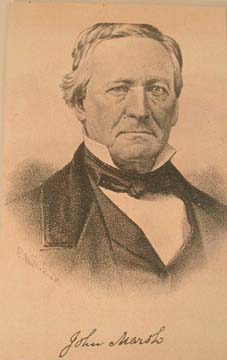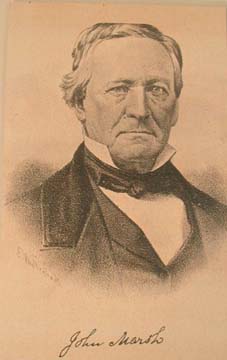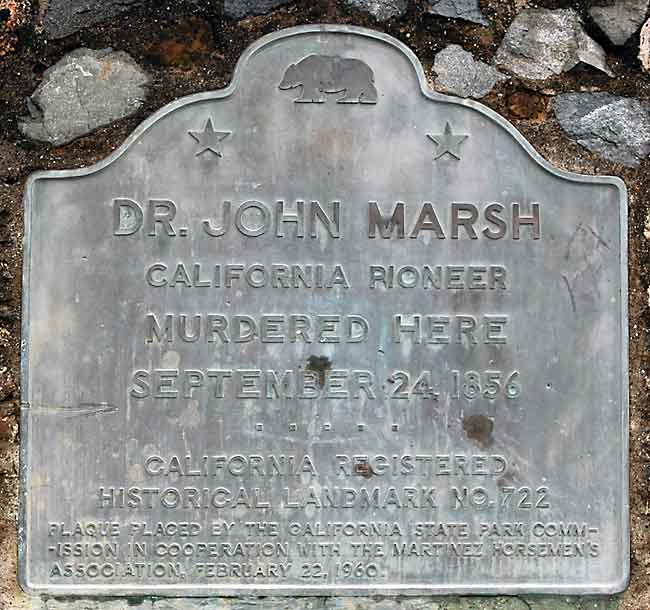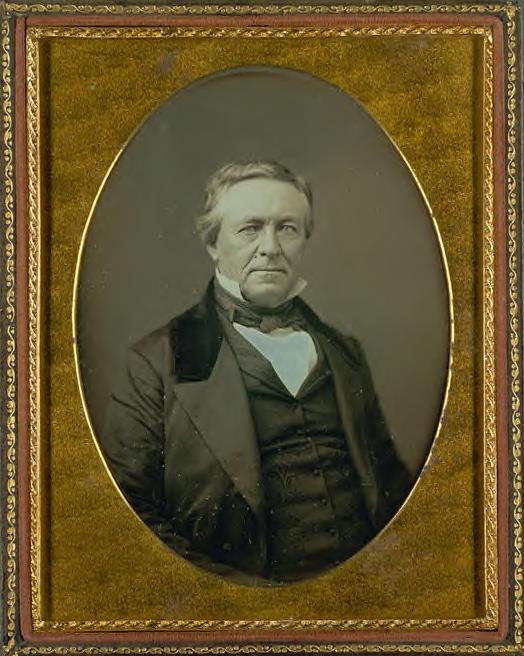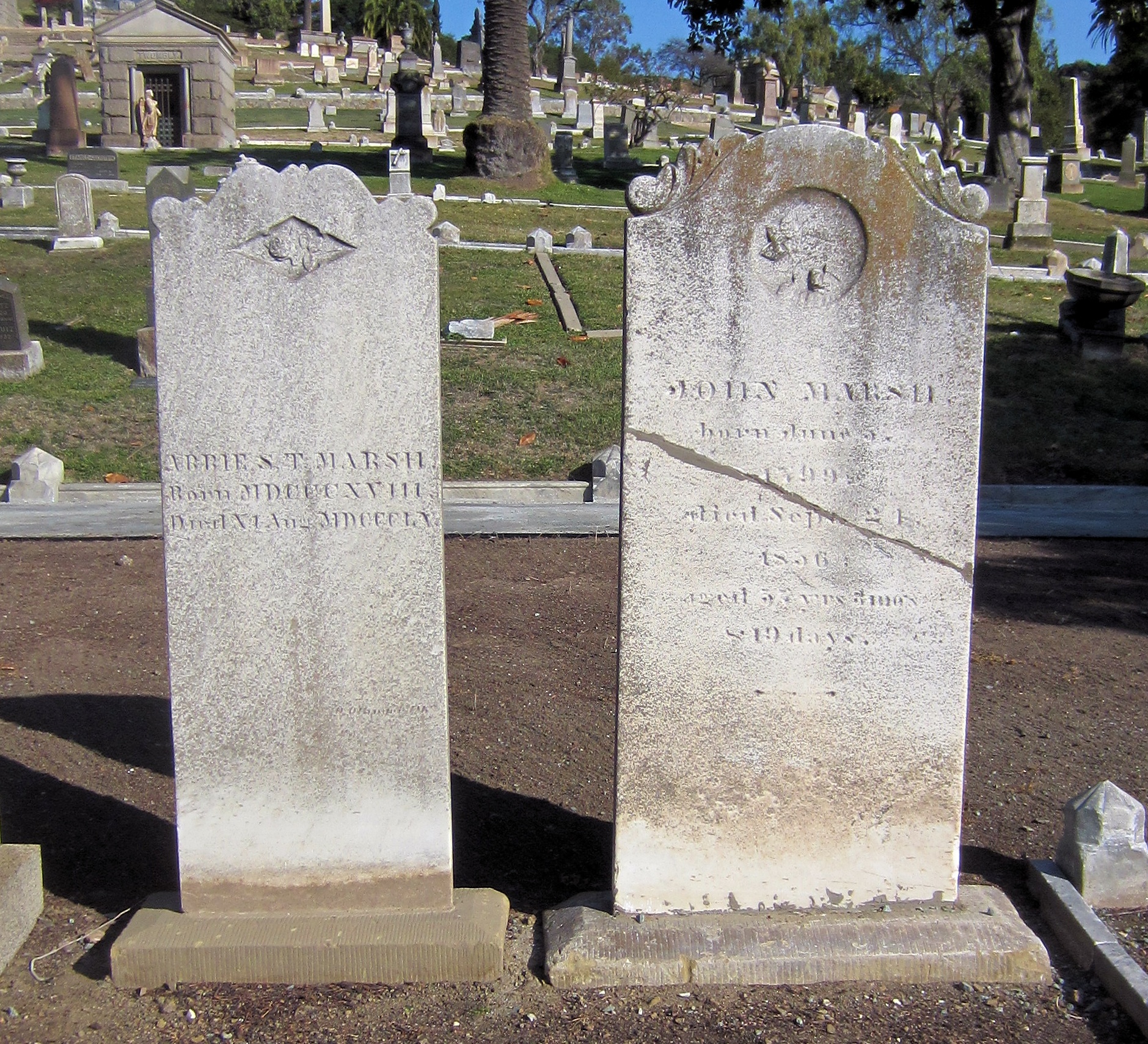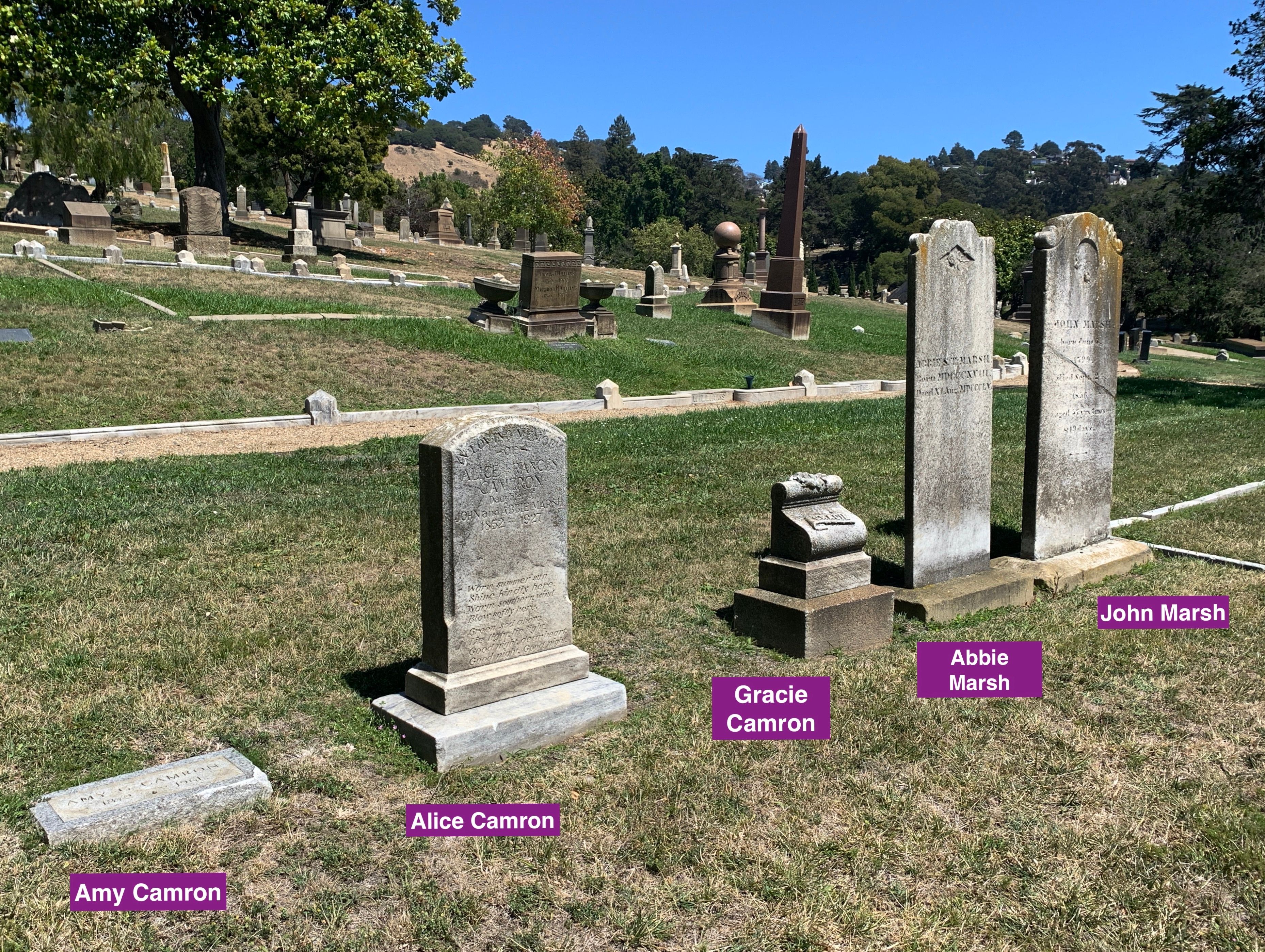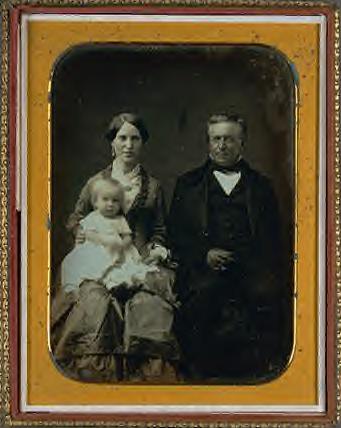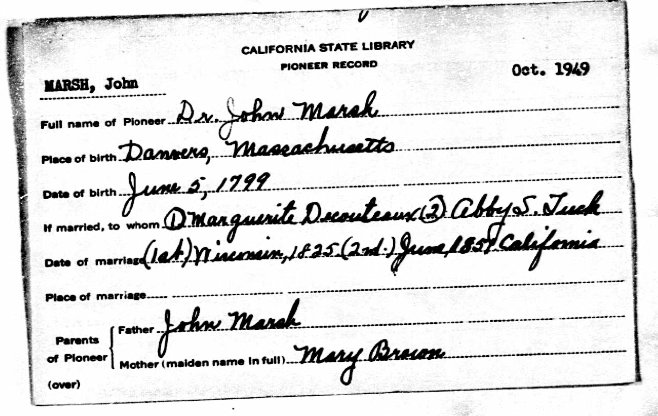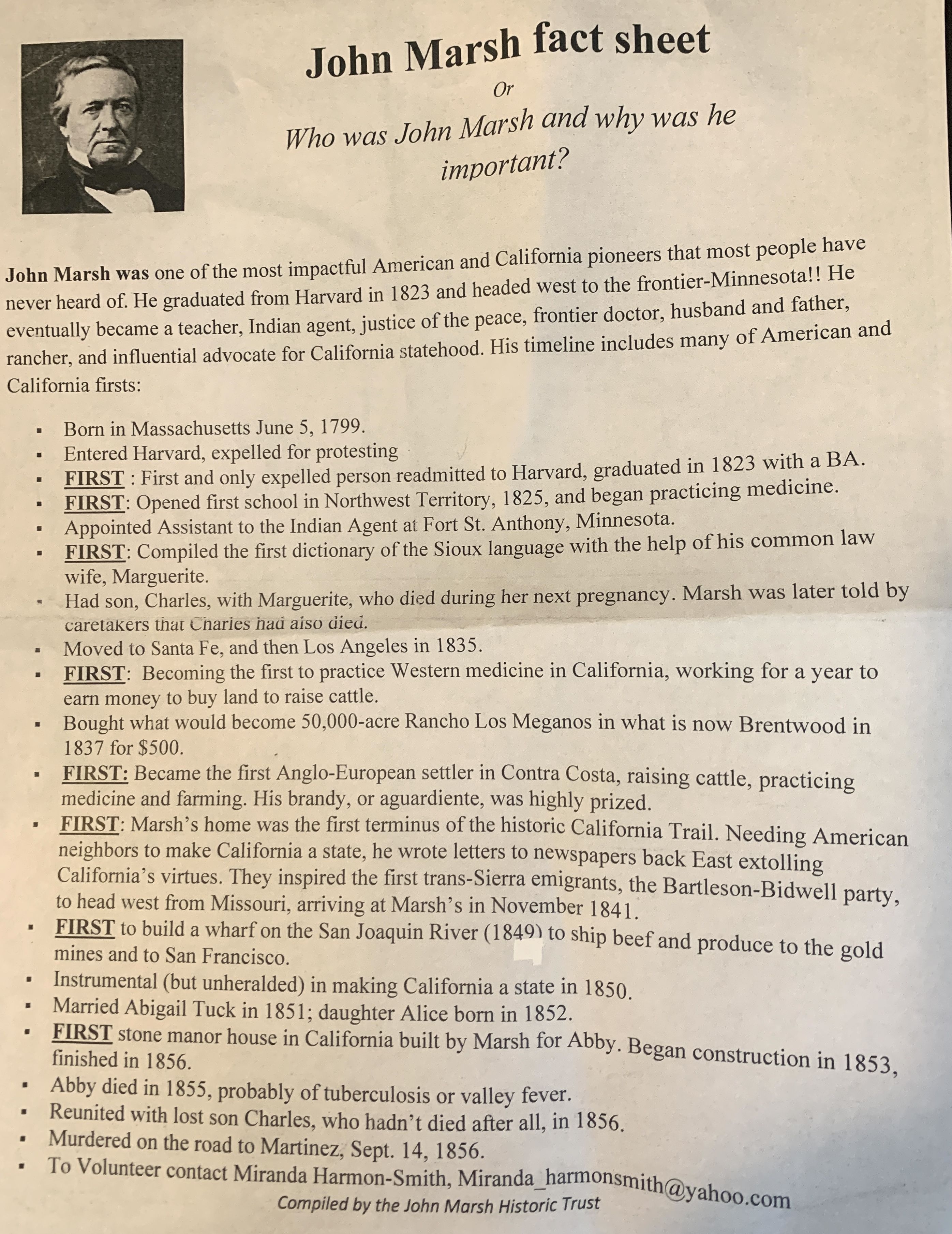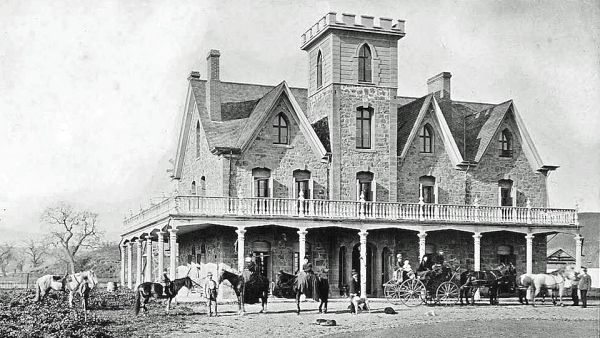Dr. John Marsh was born 1799, in Salem, Massachusetts. He attended Phillips Academy, Andover, in his prep days and later graduated at Harvard, class of 1823. John went to Fort Snelling, Minnesota, where he taught the first school. He became the assistant to the Indian Agent at Fort St. Anthony in Minnesota for a time before he studied medicine under the eye of a post physician but never received an official certificate due to the death of his mentor. John became a staunch supporter of the Sioux [Lakota] during the tribal difficulties that finally erupted into the Black Hawk War [1832] area of Prairie du Chien, Wisconsin. Already in 1828 he had rescued the wife and child of an influential Sioux chief, being held captive by Morgan, war chief of the Fox tribe. One of John Marsh's acts is quoted as a cause leading up to the Black Hawk War. He was a witness of the treaty that terminated that struggle, and that transferred an immense tract of land from the possession of the red man into the hands of the whites. While living there he had a common law wife, the beautiful daughter of a French trapper with his Wahpeton wife, her name was Marguerite. With her he compiled the first dictionary of the Sioux language and with her they had a son named Charles Marsh. From there Dr. Marsh went to Davenport, Iowa then New Salem, Illinois and set up a general store in Independence, Missouri. He moved again to Santa Fe, New Mexico Territory and then to Los Angeles, CA as rumors of gun running to the Sioux and creditors were dogging him. During this period he is known for starting prairie schooners rolling across the continent.
Dr. Marsh practiced medicine in Los Angeles [first American doctor in California in 1836] for a year to earn money to buy land. He was paid in the currency of the Pueblo [de los Angeles], hides and tallow. He arrived in San Jose in 1837 inquiring after land for sale. He purchased Rancho Los Meganos from Jose Noriega for $500 and took possession of the property in 1838, a year before John Sutter took up his grant on the Sacramento. John, his first family behind him, built a small adobe along a stream and began practicing medicine. His fees, paid in cattle, created one of the largest herds in early California [Alta CA]. He then began a letter campaign to bring American settlers to California. One was to Governor Cass of Michigan correctly evaluating the agricultural potential of California. These letters brought the first wagon trains to California and thousands of other settlers followed. Another accomplishment was helping free California from the last Mexican governor, thereby paving the way to California's ultimate acquisition by the United States.
Dr. Marsh developed Rancho Los Meganos into one of the largest ranches in the area and shipped beef and produce to the gold mines and to San Francisco. He married Abigail Tuck in 1851 and a daughter Alice Marsh was born in 1852. A year before his murder, Dr. Marsh was reunited with his lost son Charles, who had come West to find his father. On 24 September 1856, near Martinez, Contra Costa County, CA, Dr. Marsh was accosted by three young men on a dusty road; Jose Antonio Olivas, Felipe Moreno and Juan Garcia. According to Olivas, he only wanted payment for vaquero work he had done for the doctor but Felipe had other ideas and proved fatal to Dr. Marsh. He stabbed him three times, one being in the throat, and the doctor fell dead in a ditch. Felipe robbed Dr. Marsh and gave some of it to the other two young men. The horse and buggy came into Martinez the next day and a search party finially found the dead doctor. A search party led the authorities to apprehend two of the men involved, Felipe Moreno and Jose Antonio Olivas. Juan Garcia was never found. They were arrested and place in jail to await trial. Both escaped and were not heard of for at least 11 years. In September of 1866, Jose Antonio Olivas was captured in Santa Barbara County, CA and Felipe Moreno was captured in Sacramento, using a alias. They were taken back to Contra Costa County and the trial commenced. Jose turned State's evidence against Felipe, stating Felipe was the one who did the killing, not just for the money, but for the killing also. Felipe was sentenced to life in a state prison [supposedly, after 25 years, his sentence was commuted by the governor of California] and Jose's sentence is unknown, although it is inferred his punishment was very slight, or possibly none. So unfortunate a fate for Dr. John Marsh, after all the life he did live in a short time, just reunited with his lost son and with a new baby girl and wonderful large home.
"Many of Marsh's deeds were greater than the man himself. Many fell far short. Sometimes he destroyed. Mostly he builded. He was strong. He was weak. He was great. He was small. He loved. He hated. But always he was human. On every occasion but one he was master of circumstances. Even then, in defeat, he was heroic. Whatever John Marsh went there was romance and adventure. His life reads like a volume of fiction. The name of Marsh should be a household word. Yet Fate, for some inscrutable reason, denied him a place among the immortals."
GEORGE D. LYMAN
San Francisco May, 1930
(Excerpt from Preface to the definitive biography of John Marsh: JOHN MARSH, PIONEER, by George D. Lyman, NY, 1930, Scribner's and Sons)
From the book: "History of Contra Costa County, CA":
"MURDER OF DR. JOHN MARSH"
Perhaps no more horrible crime than the murder of this pioneer can be found on the pages of any history, and certainly no better example of justice following the guilty than which tracked one of the murderers to punishment eleven years after the commission of his foul deed.
Dr. Marsh had been for many years, long before the American occupation of California, the owner of the Los Meganos Rancho, of which he became possessed, as we have elsewhere stated, by purchase in the year 1837. Here he dwelt, surrounded by his people, flocks and herds, for full two decades. On or about the 24th day of September 1856, business called him from his farm to Martinez, some 30 miles distant. In the grey dawn of the following morning his horse and buggy were found in the town of Martinez, but without an occupant. Then followed the search, which led to the discovery of his body in a road-side ditch, immediately upon which the pursuit of the murderers was undertaken. On the day following Jose Antonio Olivas was captured; after making confession as to certain money found in his possession, taken from the body of the murdered victim, and implicating Felipe Moreno as principal in the deed, he was tried and convicted, but escaping from jail, he eluded justice for more than ten years. In September of 1866, he was re-captured in Santa Barbara County, and brought to Contra Costa County to await his trial."
Moreno was arrested about the same time in Sacramento. He received a life sentence in State prison but I believe the Governor pardoned him after 25 years. Juan Garcia, the third member involved in the murder and robbery, was never found. Jose Antonio Olivas was possibly born of the well known Santa Barbara Olivas family and it is possible he went to Martinez or Pacheco to work as a vaquero. After Jose escaped from jail, it is possible he came back to Santa Barbara and kept a low profile until September 1864, when he enlisted in the 1st Battalion Native California Cavalry, Company C. After the regiment was mustered out in San Franciso in 1866, he returned back to Santa Barbara, where, with the authorities still looking for him, arrested him and took him back to Contra Costa for trial. Supposedly, because he gave state's evidence against Moreno, Olivas was given a slight sentence, or no sentence of prison time.
Sincerely, Terry W. Chaffee
Carlsbad, CA
Dr. John Marsh was born 1799, in Salem, Massachusetts. He attended Phillips Academy, Andover, in his prep days and later graduated at Harvard, class of 1823. John went to Fort Snelling, Minnesota, where he taught the first school. He became the assistant to the Indian Agent at Fort St. Anthony in Minnesota for a time before he studied medicine under the eye of a post physician but never received an official certificate due to the death of his mentor. John became a staunch supporter of the Sioux [Lakota] during the tribal difficulties that finally erupted into the Black Hawk War [1832] area of Prairie du Chien, Wisconsin. Already in 1828 he had rescued the wife and child of an influential Sioux chief, being held captive by Morgan, war chief of the Fox tribe. One of John Marsh's acts is quoted as a cause leading up to the Black Hawk War. He was a witness of the treaty that terminated that struggle, and that transferred an immense tract of land from the possession of the red man into the hands of the whites. While living there he had a common law wife, the beautiful daughter of a French trapper with his Wahpeton wife, her name was Marguerite. With her he compiled the first dictionary of the Sioux language and with her they had a son named Charles Marsh. From there Dr. Marsh went to Davenport, Iowa then New Salem, Illinois and set up a general store in Independence, Missouri. He moved again to Santa Fe, New Mexico Territory and then to Los Angeles, CA as rumors of gun running to the Sioux and creditors were dogging him. During this period he is known for starting prairie schooners rolling across the continent.
Dr. Marsh practiced medicine in Los Angeles [first American doctor in California in 1836] for a year to earn money to buy land. He was paid in the currency of the Pueblo [de los Angeles], hides and tallow. He arrived in San Jose in 1837 inquiring after land for sale. He purchased Rancho Los Meganos from Jose Noriega for $500 and took possession of the property in 1838, a year before John Sutter took up his grant on the Sacramento. John, his first family behind him, built a small adobe along a stream and began practicing medicine. His fees, paid in cattle, created one of the largest herds in early California [Alta CA]. He then began a letter campaign to bring American settlers to California. One was to Governor Cass of Michigan correctly evaluating the agricultural potential of California. These letters brought the first wagon trains to California and thousands of other settlers followed. Another accomplishment was helping free California from the last Mexican governor, thereby paving the way to California's ultimate acquisition by the United States.
Dr. Marsh developed Rancho Los Meganos into one of the largest ranches in the area and shipped beef and produce to the gold mines and to San Francisco. He married Abigail Tuck in 1851 and a daughter Alice Marsh was born in 1852. A year before his murder, Dr. Marsh was reunited with his lost son Charles, who had come West to find his father. On 24 September 1856, near Martinez, Contra Costa County, CA, Dr. Marsh was accosted by three young men on a dusty road; Jose Antonio Olivas, Felipe Moreno and Juan Garcia. According to Olivas, he only wanted payment for vaquero work he had done for the doctor but Felipe had other ideas and proved fatal to Dr. Marsh. He stabbed him three times, one being in the throat, and the doctor fell dead in a ditch. Felipe robbed Dr. Marsh and gave some of it to the other two young men. The horse and buggy came into Martinez the next day and a search party finially found the dead doctor. A search party led the authorities to apprehend two of the men involved, Felipe Moreno and Jose Antonio Olivas. Juan Garcia was never found. They were arrested and place in jail to await trial. Both escaped and were not heard of for at least 11 years. In September of 1866, Jose Antonio Olivas was captured in Santa Barbara County, CA and Felipe Moreno was captured in Sacramento, using a alias. They were taken back to Contra Costa County and the trial commenced. Jose turned State's evidence against Felipe, stating Felipe was the one who did the killing, not just for the money, but for the killing also. Felipe was sentenced to life in a state prison [supposedly, after 25 years, his sentence was commuted by the governor of California] and Jose's sentence is unknown, although it is inferred his punishment was very slight, or possibly none. So unfortunate a fate for Dr. John Marsh, after all the life he did live in a short time, just reunited with his lost son and with a new baby girl and wonderful large home.
"Many of Marsh's deeds were greater than the man himself. Many fell far short. Sometimes he destroyed. Mostly he builded. He was strong. He was weak. He was great. He was small. He loved. He hated. But always he was human. On every occasion but one he was master of circumstances. Even then, in defeat, he was heroic. Whatever John Marsh went there was romance and adventure. His life reads like a volume of fiction. The name of Marsh should be a household word. Yet Fate, for some inscrutable reason, denied him a place among the immortals."
GEORGE D. LYMAN
San Francisco May, 1930
(Excerpt from Preface to the definitive biography of John Marsh: JOHN MARSH, PIONEER, by George D. Lyman, NY, 1930, Scribner's and Sons)
From the book: "History of Contra Costa County, CA":
"MURDER OF DR. JOHN MARSH"
Perhaps no more horrible crime than the murder of this pioneer can be found on the pages of any history, and certainly no better example of justice following the guilty than which tracked one of the murderers to punishment eleven years after the commission of his foul deed.
Dr. Marsh had been for many years, long before the American occupation of California, the owner of the Los Meganos Rancho, of which he became possessed, as we have elsewhere stated, by purchase in the year 1837. Here he dwelt, surrounded by his people, flocks and herds, for full two decades. On or about the 24th day of September 1856, business called him from his farm to Martinez, some 30 miles distant. In the grey dawn of the following morning his horse and buggy were found in the town of Martinez, but without an occupant. Then followed the search, which led to the discovery of his body in a road-side ditch, immediately upon which the pursuit of the murderers was undertaken. On the day following Jose Antonio Olivas was captured; after making confession as to certain money found in his possession, taken from the body of the murdered victim, and implicating Felipe Moreno as principal in the deed, he was tried and convicted, but escaping from jail, he eluded justice for more than ten years. In September of 1866, he was re-captured in Santa Barbara County, and brought to Contra Costa County to await his trial."
Moreno was arrested about the same time in Sacramento. He received a life sentence in State prison but I believe the Governor pardoned him after 25 years. Juan Garcia, the third member involved in the murder and robbery, was never found. Jose Antonio Olivas was possibly born of the well known Santa Barbara Olivas family and it is possible he went to Martinez or Pacheco to work as a vaquero. After Jose escaped from jail, it is possible he came back to Santa Barbara and kept a low profile until September 1864, when he enlisted in the 1st Battalion Native California Cavalry, Company C. After the regiment was mustered out in San Franciso in 1866, he returned back to Santa Barbara, where, with the authorities still looking for him, arrested him and took him back to Contra Costa for trial. Supposedly, because he gave state's evidence against Moreno, Olivas was given a slight sentence, or no sentence of prison time.
Sincerely, Terry W. Chaffee
Carlsbad, CA
Family Members
Advertisement
Records on Ancestry
Sponsored by Ancestry
Advertisement
